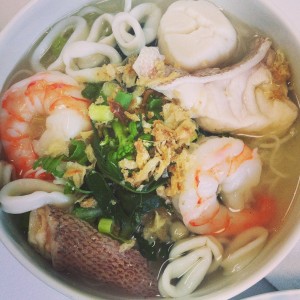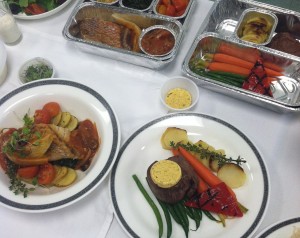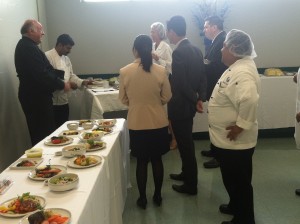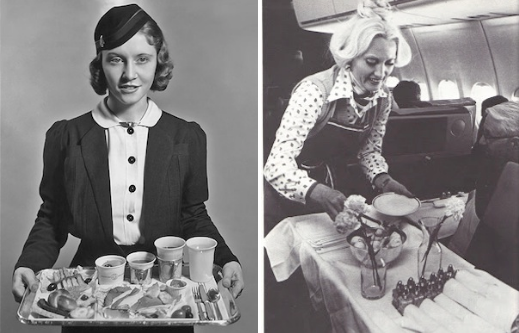Earlier this week I was invited out to a warehouse at Bush Intercontinental Airport to visit Chelsea Food Services, the huge company that caters food for inflight dining. Chelsea services airlines such as Singapore and United.
While I love to travel, I hadn’t given much thought to how food service works or the logistics involved. All I know is that it has become hard to find a flight that includes meals and snacks as part of the basic ticket purchase. Singapore Airlines has been recognized again this year (most recently by Saveur magazine) for offering passengers better dining options while flying.
 Every few months Singapore Airlines executive chef Hermann Freidanck travels to hubs like Houston to design new menus and update his airlines’ current crowd-pleasers. The local hub catering chef Shashi Sanamvenkata and Singapore Airlines’ head chef put their heads together and assemble menus that satisfy the dining needs of passengers who are departing from Houston and arriving in the airlines’ various destinations, including Southeast Asia and Russia.
Every few months Singapore Airlines executive chef Hermann Freidanck travels to hubs like Houston to design new menus and update his airlines’ current crowd-pleasers. The local hub catering chef Shashi Sanamvenkata and Singapore Airlines’ head chef put their heads together and assemble menus that satisfy the dining needs of passengers who are departing from Houston and arriving in the airlines’ various destinations, including Southeast Asia and Russia.
For example, Houston commonly has many passengers flying to Vietnam. In order to please those customers, the menu generally has an element of Vietnamese comfort food. However, London’s Singapore Airlines customers are largely Indian, with several daily flights to different destinations in India. The menu for London’s Heathrow passengers on those flights offers both vegetarian and non-vegetarian Indian options.
 If developing dozens of different menus for first-class, business-class and economy-class passengers six times a year isn’t enough to make your head spin, consider the operational logistics. Just like in a restaurant, the airline must look at their budget (per person’s ticket) when factoring food costs per meal and per passenger. Each plate must be pre-packed in small containers, packed into different-sized carts — depending on the size and model of plane in which they are being loaded — and stored onboard until service begins at 35,000 feet.
If developing dozens of different menus for first-class, business-class and economy-class passengers six times a year isn’t enough to make your head spin, consider the operational logistics. Just like in a restaurant, the airline must look at their budget (per person’s ticket) when factoring food costs per meal and per passenger. Each plate must be pre-packed in small containers, packed into different-sized carts — depending on the size and model of plane in which they are being loaded — and stored onboard until service begins at 35,000 feet.
Then, each passenger’s food order is prepared using the tiny hotbox ovens. In most cases, tiny tin and plastic containers (as shown at left) must be emptied and assembled by airline attendants in an itty-bitty “kitchen” with about one square foot of working space. The attendants follow specific instructions for plating food so that your kubideh or curry or breakfast sausage arrives looking as divine as possible.
 Imagine an international flight of 500 guests flying 12 hours. The flight would include two meals and a snack — and we’re not talking about peanuts. Menu choices include rack of lamb, fish soup, beef filet, a variety of curries — even catfish.
Imagine an international flight of 500 guests flying 12 hours. The flight would include two meals and a snack — and we’re not talking about peanuts. Menu choices include rack of lamb, fish soup, beef filet, a variety of curries — even catfish.
Fuel costs (to support the added weight of the food and carts) must also be factored in. You need kilos of fuel to support the transportation of fliers … and their fuel, food.
When I asked the Singapore chef team what guests departing out of Houston have seemed to enjoy most each time there is a menu update, the answer didn’t surprise me: The filet wins every time. Oh, and the Champagne, too, of course.
Singapore Airlines’ newest inflight menu will take off November 1, 2014.









Follow Us